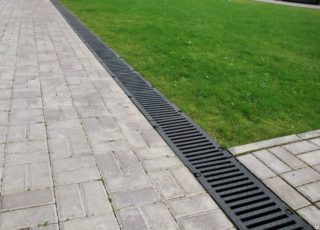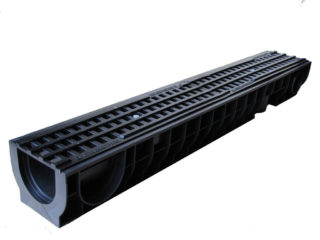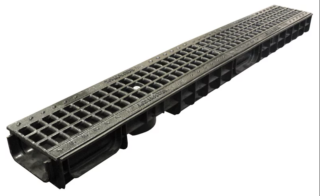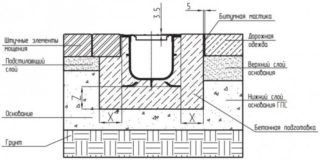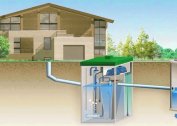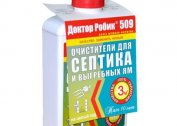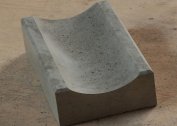A reliable drainage system protects buildings and structures from the negative effects of excess moisture. For the installation of communication use plastic drainage trays with a grate or gutters made of cast iron, concrete, polymer sand materials. Each type has its own dimensions and specifications.
Definition and scope
The gutter is a tray of a specific length. Its depth, height and width determine the throughput of the product. The upper part of the tray is closed with a protective grill.
Channels are used to create a drainage system at such facilities:
- garden paths, park areas;
- motorways, autobahns, city roads;
- port docks;
- Airports
- washing stations for cars;
- playgrounds;
- parking, parking lots.
Often gutters are used in industrial plants to eliminate contaminated effluents into the city sewer.
Device and material of manufacture
Gutters for the discharge of storm drains are U-shaped or U-shaped. The height of the sides of such products is the same on both sides. On the curb trays, there is an L-shaped edge protrusion on one edge that allows the gutter to be fixed.
For trays that are mounted in public places, there are upper grilles with a special locking mechanism for protection from vandals.
There are several varieties of gutters on the market for a sewage system. The most popular are:
- polymer;
- polymer sand;
- cast iron;
- reinforced concrete;
- polymer concrete.
Each of them is used in certain areas with different load intensities.
Polymer gutters
Plastic trays for storm sewers are in great demand among private craftsmen. Since the load class is not very high, the gutters are mainly used in private households.
Thanks to the mineral additives included in the polymer composition, the trays withstand aggressive environments, mechanical stresses. Due to the perfectly smooth inner walls of the channels, the water leaves quickly. The service life of polymer gutters is 50 years or more. The weight is only 7-9 kg / pc, so one master can carry out the transportation and laying of channels.
Common sizes of polymer trough:
- width - 0.15-0.5 m;
- length - 1-1.5 m;
- side height - 0.79-0.6 m;
- section —0.1 m.
A variety of polymer trays are polymer sand products. To the plastic mass during production add a granular mixture of a fine fraction. Gutters are made by pressing. The result is a durable, resistant to mechanical pressure, static / dynamic loads product.
The polymer sand tray can be used at temperatures from -50 degrees to +120. At the same time, it responds well to aggressive environments. The load class of such products is C250, so they can be used not only in private construction, but also in urban facilities. The main advantage is the low weight of the gutters. The master will cope with the stormwater device in one hand.
Cast Iron Trays
This type of metal has high strength to longitudinal and transverse loads, therefore cast-iron trays are often used in places with maximum load - airports, seaports, truck parking, runways. For the resistance of cast iron to corrosion, it is additionally galvanized.In private areas, the use of such gutters is impractical due to their high cost. Typical sizes of cast iron trays:
- width - up to 0.2 m;
- length - up to 0.5 m;
- internal section - from 100 mm.
Sometimes the length of the cast-iron channel is made somewhat larger according to the special requirements of the customer.
Concrete, polymer concrete gutters
Even 20 years ago, manufacturers made drainage trays exclusively from reinforced concrete. Products had a large weight, a relatively smooth inner surface of the walls, and were resistant to mechanical stress and aggressive environments. For the installation of concrete storming, special equipment was required.
To significantly reduce the mass of one product and at the same time increase its resistance to static / dynamic loads, polymers began to be added to the concrete mass during the production of the tray. As a result, the gutters are many times lighter and stronger. Their inner walls are perfectly smooth. Such polymer concrete channels serve up to 30-40 years, can be operated at a wide temperature range, and are resistant to longitudinal and transverse loads. They are often used both in suburban construction, and in the installation of stormwater in urban facilities. Sizes of concrete, polymer concrete channels:
- width - 0.43-0.14 m;
- length - 0.5-4 m;
- wall height - 0.15-0.87 m;
- internal section - from DN 100.
Thanks to the improvement of the technology for the production of polymer concrete gutters, their load class can reach F900.
Types of grates for trays
The upper protective grilles for the drainage channels are made of galvanized steel (stainless steel), cast iron or polymer sand composition. All of them vary in size, shape of the gap, color. More often do black grilles or steel shade.
By design, these types of products are distinguished:
- slotted - has a longitudinal slot for water to enter the tray;
- cellular - equipped with transverse cracks;
- wavy - slots are located in waves from one and the other edges of the lattice.
Product design does not affect their throughput.
Criterias of choice
The selection of channels for the installation of a shower must be done based on the following parameters:
- Tray throughput. Calculate, based on the type of coverage on the site, the average rainfall in the region for the year. It is advisable to multiply the obtained results by another 25% in order to have a margin of safety.
- Load class. It is impractical to install cast iron gutters with a high class on a private site, as well as on complex objects with increased traffic - polymer trays.
- Type of protective grill. It can be with or without a locking mechanism. The upper grille is also selected according to the load class.
It is important to consider the total length of storm sewers. This will help to buy the right number of trays.
Installation Rules
When installing gutters for drainage, experts advise to adhere to such rules:
- Trays are always set on a special sand cushion. Concrete products are mounted on a pre-poured mortar layer.
- It is important to observe a slope of rainfall at a rate of 10 mm per meter. This will ensure free outflow of water from the facility.
- It is advisable to install sand traps. They prevent siltation of the system.
- The upper grilles must be fixed.
In order for the storm to work properly, you must regularly clean it. To do this, once or twice a season, raise the upper grilles and remove the debris accumulated inside.
Cost of drainage trays
The prices of the drainage drainage tray vary depending on the material of manufacture and the internal section. Approximate minimum cost of gutters for the Moscow region:
| Product type | Price |
| Hydrolik Plastic Drainage Tray | From 240 rub / piece |
| Polymer sand | From 330 rub / piece |
| Concrete | From 3 700 rub / piece |
| Polymer concrete | From 740 rubles / piece |
| Cast iron | From 2 200 rub / piece |
In general, it is more profitable and more convenient for a suburban area to use polymer gutters to discharge storm drains.
